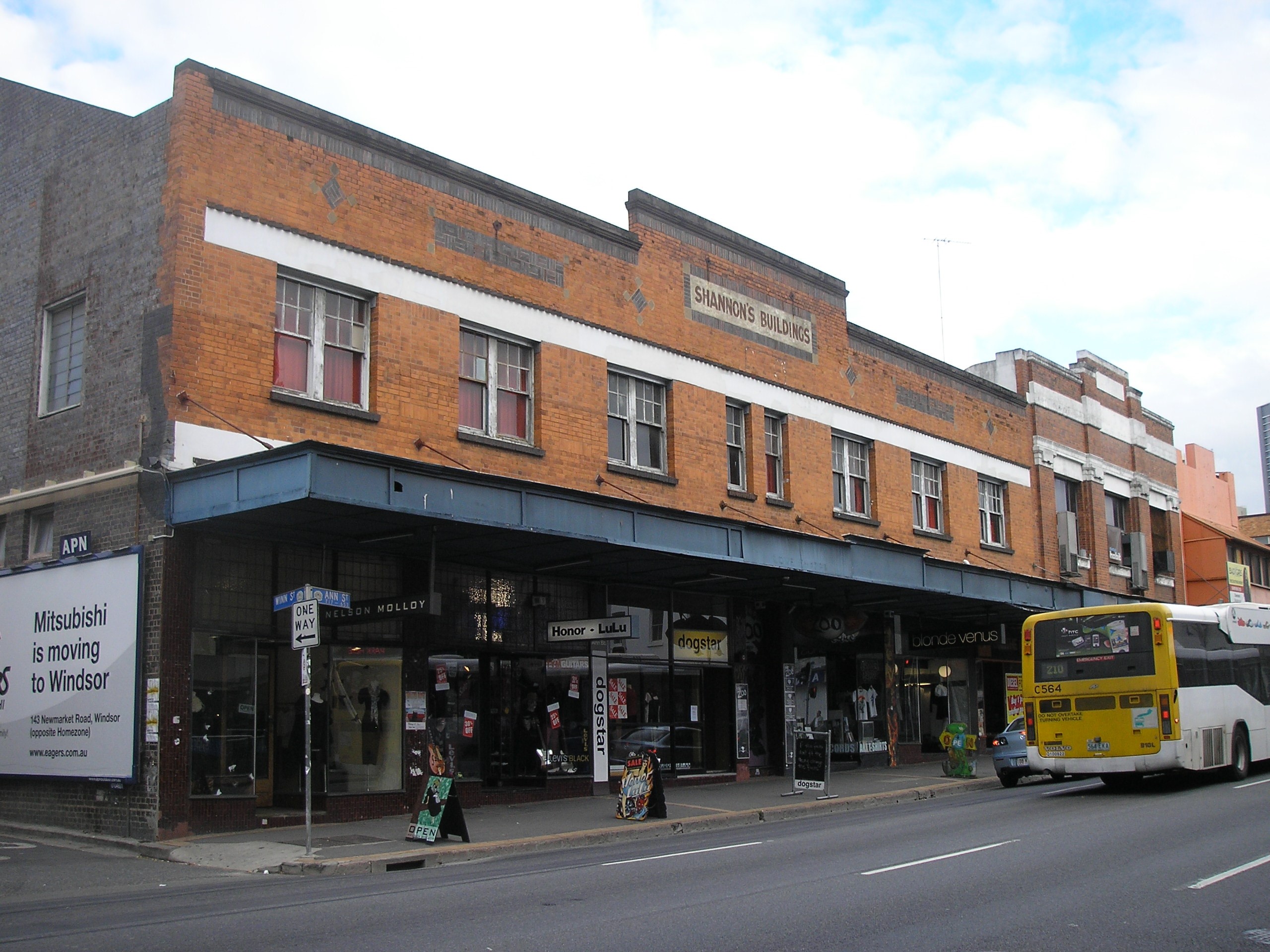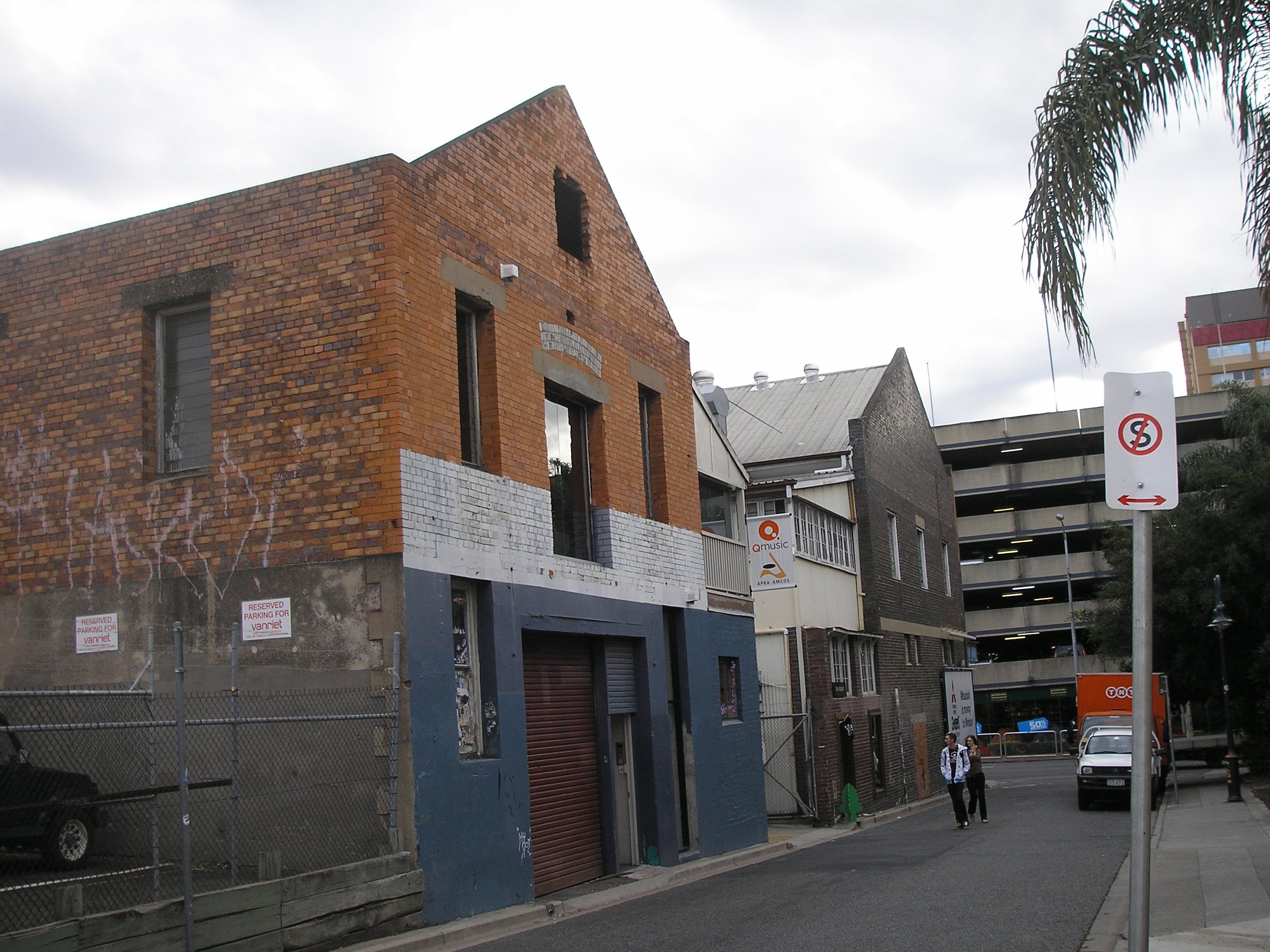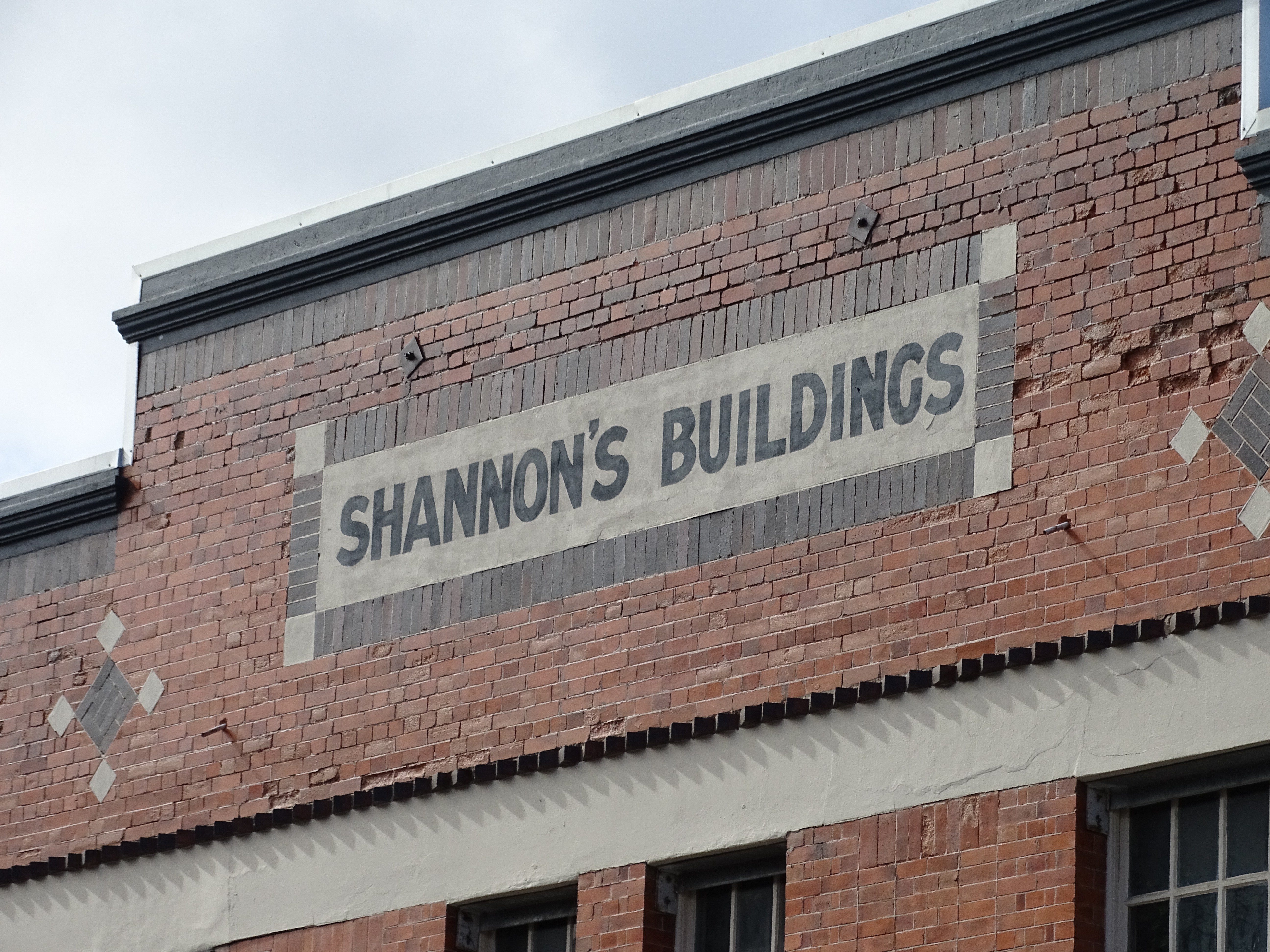Addresses
Type of place
Shop/s, Warehouse
Period
Interwar 1919-1939
Style
Free Style
Addresses
Type of place
Shop/s, Warehouse
Period
Interwar 1919-1939
Style
Free Style
The Shannon’s building on Ann Street was built in 1924-25 and designed by renowned Brisbane architect E.P. Trewern. Shannon’s is a large two-storey brick building with six shops on the ground level and large open spaced area on the first floor. The Winn Street Warehouse is a brick warehouse on Winn Street behind the Shannon’s building, also designed by E.P. Trewern, and constructed by Reuben Shannon in 1925. Built as a set, many of the warehouse’s design features reflect the Shannon’s building. Both buildings contribute to the 1920s commercial streetscape in this area of Fortitude Valley.
Lot plan
L1_RP8841; L2_RP8841
Key dates
Local Heritage Place Since —
Date of Citation —
Construction
Walls: Face brickPeople/associations
Eric Percival Trewern (Architect)Criterion for listing
(A) Historical; (E) Aesthetic; (H) Historical associationInteractive mapping
Lot plan
L1_RP8841; L2_RP8841
Key dates
Local Heritage Place Since —
Date of Citation —
Construction
Walls: Face brickPeople/associations
Eric Percival Trewern (Architect)Criterion for listing
(A) Historical; (E) Aesthetic; (H) Historical associationInteractive mapping
History
717 – 705 Ann Street is a 1920s brick commercial premises consisting of six small ground floor shops and one large open space on the first floor. A first floor gangway connects the Ann Street building to a brick warehouse behind that has Winn Street frontage. The Ann Street building, known as the Shannon’s building and the Winn Street Warehouse was designed by successful Brisbane architect E.P. Trewern.
From the 1860s the population of the Valley grew, having over 1000 residents by this time. The commercial nature of the Valley was also beginning to emerge. Most commercial activity in this period was centred between Ann, Brunswick and Wickham Streets. The improvement of access from the city centre to the Valley due to the levelling of Duncan’s Hill between the two areas in the 1870s assisted the growth of this part of Brisbane
In the last two decades of the nineteenth century the population of the Valley increased even more, and with this the commercial nature of the Valley centre grew with relatively large scale construction in the area. As this occurred those living within the centre began to move to more suburban areas such as New Farm and Bowen Hills. By the turn of the century the valley heart was commercially dominated and the buildings were of a more substantial nature.
The success of the Valley commercial area at the turn of the century saw large traders such as TC Beirne, McWhirters and Overells department stores encourage shoppers to the Valley. Efficient public transport systems such as electric trams and trains to and through the Valley contributed to the commercial success of the area. In the late nineteenth century, the Ann Street premises housed several small shops and a residence.
The 1920s was a decade of further growth in Fortitude Valley, with its success as a commercial and industrial hub. In this decade the cutting on Duncan’s Hill for Ann Street was widened, opening the Valley even further to the rest of Brisbane, allowing a greater volume of traffic into the area.
In 1922 the property that spanned 717 - 705 Ann Street was purchased by Reuben Samuel George Shannon. He was listed at an address in Enoggera in 1923, suggesting the Ann Street address was to be an investment for Shannon. He continued to be listed at the Enoggera address well into the 1930s, confirming the commercial nature of the Ann Street investment.
Between 1923 and 1925 there were no listings in the Post Office Directory for the Ann Street address, suggesting the new brick building was in the process of being built. On July 7, 1923, The Architect’s and Builder’s Journal of Queensland published a set of plans for the new building on Ann Street. The designs depict a brick building with six shop frontages on the ground floor and four upstairs residential apartments. Each ground floor shop was designed with separate rear access and the residential quarters upstairs had a central staircase to both the front and rear ground floor entrances. The brick building was designed by E.P. Trewern, one of Brisbane’s most successful architects at this time.
Victorian trained Eric Percival Trewern established his Brisbane architectural practice in 1920 at an address in Queen Street, Brisbane. The practice continued until Trewern’s death in 1959. The height of his design success occurred in the interwar period and he is renowned for his innovative designs incorporating the Spanish Mission and the Old English/Tudor revival style in residential and commercial architecture. Amongst his finest residential designs is the New Farm house “Santa Barbara” that is considered the best example of the Spanish Mission style in Brisbane. Trewern designed many commercial buildings in central Brisbane many of which no longer exist. One important extant building is the Inchcolm Professional Chambers on Wickham Terrace. Trewern was an active member of many prestigious architectural societies in the pursuit of improving professional architectural standards in Queensland.
The proposed new building was recorded as approved in the February 1925 Register of New Buildings and was described as a ‘New Building’ on ‘Ann Street, Valley’, with brick shops and flats designed by E.P. Trewern, Queen Street. Reuben Shannon, the owner was also the builder. The original drawings of the Shannon’s building differ in some details from the building that was finally built. The brick façade of the building was originally designed with three decorative brick gables on the roof line, several large bay windows on the first floor, and elaborate decorative brick work. The constructed building followed the basic design of the plans, six ground floor shops with separate rear entrances, central ground floor entrance door with staircase to first floor, row of timber sash windows on first floor frontage. The more elaborate design features were toned down to incorporate less decorative diaper-bond brickwork in the façade, a row of six double and two single timber sash windows on the first floor, and a non-gabled brick façade.
As mentioned, the building was initially designed with four first floor residential apartments, it is apparent however, that the apartments were not built, instead a large warehouse/factory space was created on the first floor; perhaps it was deemed more viable to make the space into a manufactory. From 1926 onward there were no residences listed at the address, only businesses. From 1926 to 1940 businesses such as furniture dealers, mechanics, ‘mixed business’ premises, used tyre dealers, stove-makers and repairers were leasing the shops. A consistent lease on the premises was Hutchinson and Wood (later Hutchinson and Son) Printers, this business leased numbers 717-715 Ann Street. The upstairs space, Number 711, was leased to various clothing manufacturers, including Harris and Co. Clothing Manufacturers from 1927- 1933, Olsens from 1937 and into the 1950s.
Included in the property Lot is the brick building behind the Shannon’s building, with frontage to Winn (previously Wynn) Street. This lot was also purchased by Shannon in 1922 at the same time he acquired the Ann Street properties. In 1924 The Register of New Buildings recorded the approval of plans to build a brick warehouse on the site. The warehouse was to be built by day labour, the architect was E.P. Trewern. The building would cost ₤4126. The design of the warehouse incorporated many of the same elements used by Trewern in the Shannon’s building, creating a set of substantial, brick commercial buildings. A winch and pulley hauling system was originally built into the design of the warehouse to assist in the distribution of goods. Evidence of this can be seen in the front brick façade and includes an opening in the brick gable façade and a first floor receiving entrance that faces the road below. The windows throughout the warehouse have been replaced by louvers.
By 1925, Shannon was leasing the newly built warehouse to the Motor Supplies Company, vulcanising department. In 1929 the lease was transferred to the Peanut Products Merchants and Manufacturers Company, this company continued occupancy of the warehouse well into the 1950s.
The Shannon’s Building and Winn Street Warehouse are rare surviving examples of E.P. Trewern’s commercial work in Brisbane. As a set, the two substantial brick buildings contribute greatly to the historic landscape of Fortitude Valley retail centre and share design features that create architectural consistency at the corner of Ann and Winn Street.
The Shannon’s building is today playing a similar role in Brisbane as it did when it was first built in the 1920s. The six ground floor shops offer an array of products, from high fashion, to a cult-movie video shop. The first floor is occupied by the ‘Zoo’ Nightclub, a favourite night spot for Brisbane’s nightlife goers. The Winn Street warehouse is being used as offices and a café.
Description
Shannon’s building has six ground floor shops with separate rear entrances, central ground floor entrance door with staircase to first floor, row of timber sash windows on first floor frontage. The building has decorative diaper-bond brickwork in the façade, a row of six double and two single timber sash windows on the first floor, and a non-gabled brick façade.
Directly behind Shannon’s building on Ann Street is the large brick warehouse on Winn Street. The design of the warehouse incorporates many of the same elements used by Trewern in the Shannon’s building, creating a set of substantial, brick commercial buildings. A winch and pulley hauling system was originally built into the design of the warehouse to assist in the distribution of goods. Evidence of this can be seen in the front brick façade and includes an opening in the brick gable façade and a first floor receiving entrance that faces the road below. The windows throughout the warehouse have been replaced by louvers.
The Shannon’s building is an intact example of a 1920s commercial building that contributes to the Ann Street historic landscape. Many of the original features of the building remain, including lead light windows in the shop entrances, exterior tiling, intricate brick work within the façade, timber sash windows on the first floor, and street awning; as a set of substantial brick commercial buildings designed by the same architect, E.P. Trewern, the Shannon’s Building and the Winn Street warehouse share many design features that contribute to the aesthetic value in this area of Fortitude Valley.
Statement of significance
Relevant assessment criteria
This is a place of local heritage significance and meets one or more of the local heritage criteria under the Heritage planning scheme policy of the Brisbane City Plan 2014. It is significant because:
References
-
‘Santa Barbara’, Entry in the Queensland Heritage Register, Environmental Protection Agency
-
Historic Titles, Department of Natural Resources and Water
-
Queensland Post Office Directories
-
Trewern, E.P, “Business Premises, Valley, for R. Shannon, Esq”, July 7, 1923, A and B Journal of Queensland, p. 45
-
Watson, Donald and Judith McKay. A Directory of Queensland Architects to 1940. (St. Lucia: U of Q Press, 1984)
-
Detail Fire Survey: City of Brisbane, 1951, Mahlstedt’s: Consulting Fire Engineers and Surveyors, Melbourne
-
Metropolitan Water and Sewage Survey Maps, 1914
-
North Brisbane Electoral Rolls, 1898 and 1900
Citation prepared by — Brisbane City Council (page revised September 2020)




